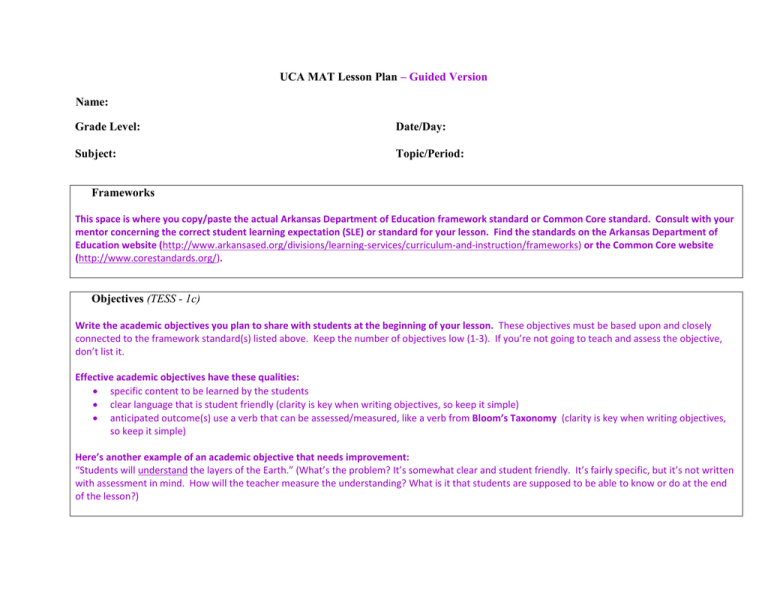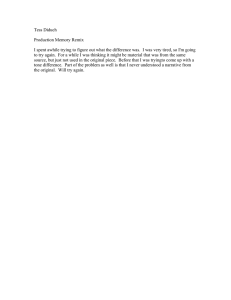UCA-MAT-Lesson-Plan-GUIDE-Revised-1-25-16
advertisement

UCA MAT Lesson Plan – Guided Version Name: Grade Level: Date/Day: Subject: Topic/Period: Frameworks This space is where you copy/paste the actual Arkansas Department of Education framework standard or Common Core standard. Consult with your mentor concerning the correct student learning expectation (SLE) or standard for your lesson. Find the standards on the Arkansas Department of Education website (http://www.arkansased.org/divisions/learning-services/curriculum-and-instruction/frameworks) or the Common Core website (http://www.corestandards.org/). Objectives (TESS - 1c) Write the academic objectives you plan to share with students at the beginning of your lesson. These objectives must be based upon and closely connected to the framework standard(s) listed above. Keep the number of objectives low (1-3). If you’re not going to teach and assess the objective, don’t list it. Effective academic objectives have these qualities: specific content to be learned by the students clear language that is student friendly (clarity is key when writing objectives, so keep it simple) anticipated outcome(s) use a verb that can be assessed/measured, like a verb from Bloom’s Taxonomy (clarity is key when writing objectives, so keep it simple) Here’s another example of an academic objective that needs improvement: “Students will understand the layers of the Earth.” (What’s the problem? It’s somewhat clear and student friendly. It’s fairly specific, but it’s not written with assessment in mind. How will the teacher measure the understanding? What is it that students are supposed to be able to know or do at the end of the lesson?) Improved version: “Students will identify and describe the layers of the Earth” or “Students will compare and contrast the layers of the Earth.” Here’s another example of an academic objective that needs improvement: “Students will demonstrate an understanding of the differences between adjectives and adverbs.” (Same issue…not measureable.) Improved version: “Students will describe similarities and differences between adjectives and adverbs.” All of the improved versions use verbs that are measureable because they describe what the teacher could ask students to do at the end of the lesson to measure student learning. Be cautious about mistaking an activity for an academic objective. Here’s another example of an academic objective that needs improvement: “Students will build a model of the layers of the Earth.” (This is what the students will do, rather than what the students will learn.) Improved version: “Students will identify and describe the layers of the Earth.” Here’s another example of an academic objective that needs improvement: “Students will participate in a discussion of the digestive system.” (Again, this is a great activity but not an effective learning objective.) Improved version: “Students will compare and contrast major organs of the digestive system.” Essential Question(s) (TESS 1a) List (multiple) means of content representation (TESS – 1b) In a lesson, teaching and learning are focused on “important questions that recur in life and key inquiries within a discipline” (Wiggins) that are stimulating and open ended. Usually they have no “right and wrong” answers. List the various ways you will give learners opportunities to acquire information and knowledge. Learners need to receive content using a variety of options (text, visual, auditory, kinesthetic, etc.). In simplest form, think about how many different ways the students are presented with the content. Examples might include: lecture, PPT, video, visuals, text, handson activity, peer presentations, etc. Please see this site for guidance and note key points included below from site http://www.authenticeducation.org/ae_bigideas/article.lasso?artid=53 Resource - http://www.udlcenter.org/aboutudl/udlguidelines and http://www.cast.org/udl/ A question is essential when it: 1. causes genuine and relevant inquiry into the big ideas and core content; 2. provokes deep thought, lively discussion, sustained inquiry, and new understanding as well as more questions; 3. requires students to consider alternatives, weigh evidence, support their ideas, and justify their answers; 4. stimulates vital, on-going rethinking of big ideas, assumptions, and prior lessons; 5. sparks meaningful connections with prior learning and personal experiences; 6. naturally recurs, creating opportunities for transfer to other situations and subjects. Materials (TESS – 1d) List (multiple) means of expression (TESS – 1b) List the lesson materials. List the ways you will provide learners with alternatives or options for demonstrating knowledge. In simplest form, how many different ways can your students SHOW you what they know? Options might include: group discussion, Q&A, drawing, peer presentation, writing a paper, making a piece of art, acting out a skit, creating/singing lyrics, etc. Resource - http://www.udlcenter.org/aboutudl/udlguidelines and http://www.cast.org/udl/ Differentiation for diverse learners (TESS – 1b) List (multiple) means of engagement (TESS – 1b) List the ways you will provide differentiation for your students’: cultural characteristics, learning styles, special needs List the methods used to ENGAGE your learners. Engagement is not direct instruction. Students should be actively involved in their own learning. Resource - http://www.udlcenter.org/aboutudl/udlguidelines and http://www.cast.org/udl/ Techniques (watching, listening, and/or reading) are highlighted in green. Each technique must be used one time on its own. Tools (class rosters, checklists, rubrics, anecdotal records, electronic apps, etc.) are highlighted in blue. For item 3 and 7 ONLY: Alignments between assessments and objectives are highlighted in pink. Instruction (TESS – 1e) Preassessment (measurement of prior knowledge)/ Introduction (motivation of learners) Briefly describe your Preassessment/Introduction here. The lesson introduction is a critical piece of the learning that “sets the stage” and serves to ENGAGE and MOTIVATE your learners. The lesson introduction should be a brief activity that engages your learners and allows you to preassess students’ prior knowledge. Formative Assessments (TESS – 1f) Use this pattern to record your formative assessments. (For item 3, include language that aligns the assessment to the objective.) Learner outcomes will be monitored and measured by .….. and record in ….. The assessment aligns with the objective when learners demonstrate …… Describe any activity, assignment, quiz, bell ringer, or other method of assessment that is planned for the beginning of this lesson or connects to this lesson from a recent previous lesson. Content Exploration Briefly describe your Content Exploration here. During content exploration, the teacher facilitates inquiry based on the essential question and content in various ways that engage students. In a traditional lesson, this is where the teacher would present the content to the students (i.e., lecture, PPT). In a constructivist lesson, this is where the teacher would establish the inquiry problem/project and provide the structure and resources for students to explore the content under guidance followed by teacher-provision of content as deemed necessary. Content should connect across the curriculum. Learner outcomes will be monitored and measured by .….. and record in ….. Guided Practice Briefly describe your Guided Practice here. Learner outcomes will be monitored and measured by .….. and record in ….. The students will be provided activities (usually as a group) to practice the new knowledge, skills, and dispositions. Independent Practice Briefly describe your Independent Practice here. Learner outcomes will be monitored and measured by .….. and record in ….. The students will be provided activities (usually individually) to practice the new knowledge, skills, and dispositions. This may include in class activities and out of class assignments as appropriate. Postassessment/Closure Briefly describe your Postassessment/Closure here. The lesson closure guides students to summarize and review the content learned from the lesson and to establish direction and to ask questions for subsequent lessons. The closure should include a post assessment (i.e., exit slip, quiz, writing prompt) that documents individual progress in writing. (For item 7, include language that aligns the assessment to the objective.) Learner outcomes will be monitored and measured by .….. and record in ….. The assessment aligns with the objective when learners demonstrate ……
